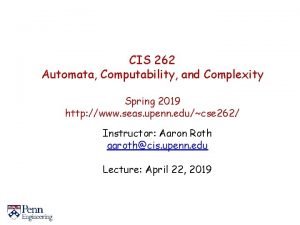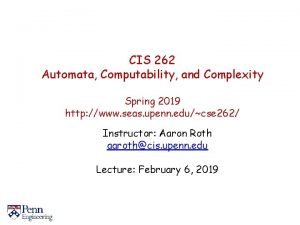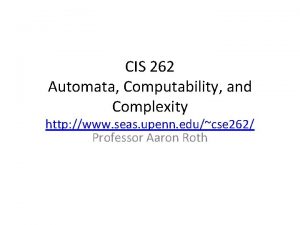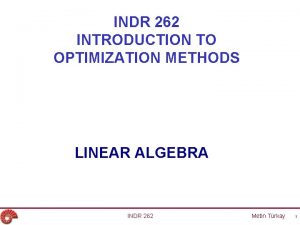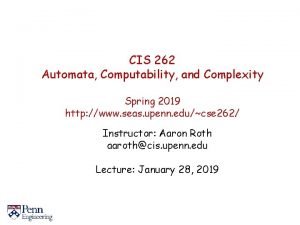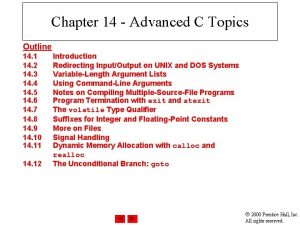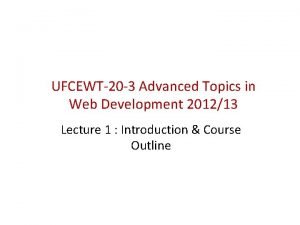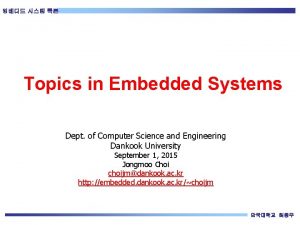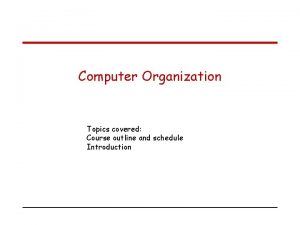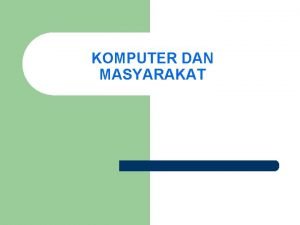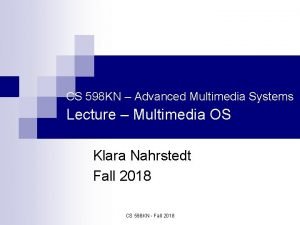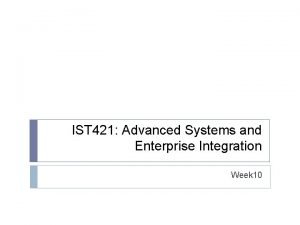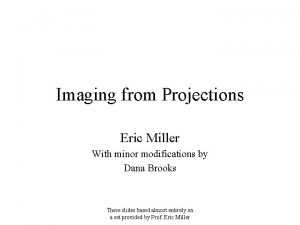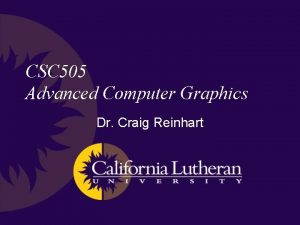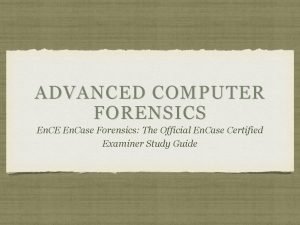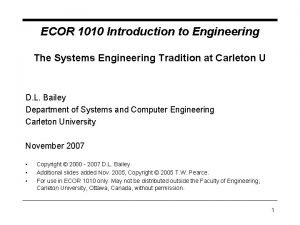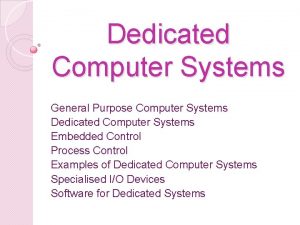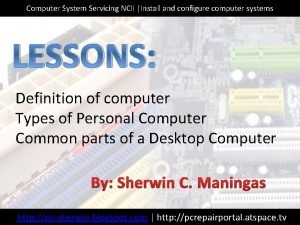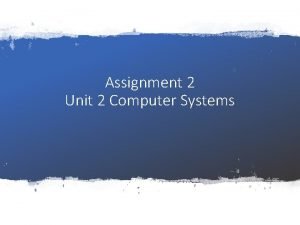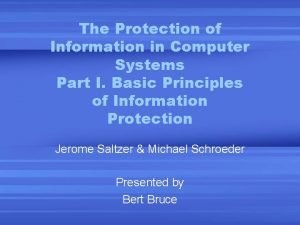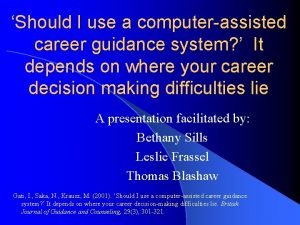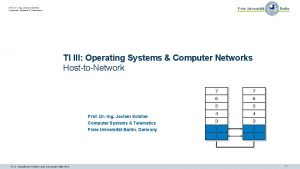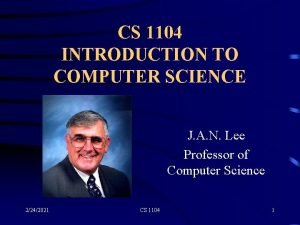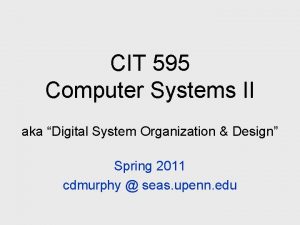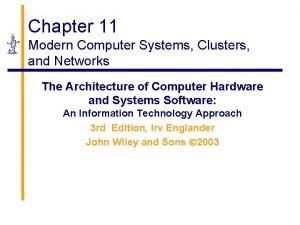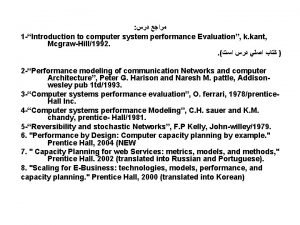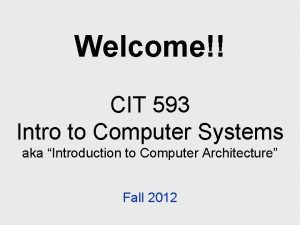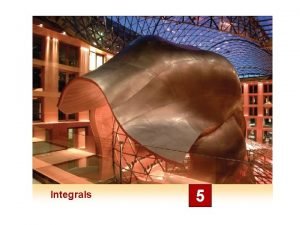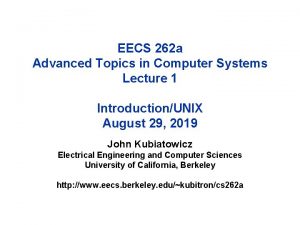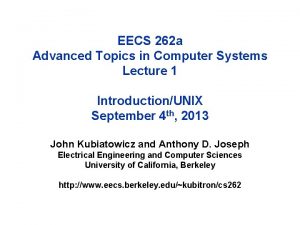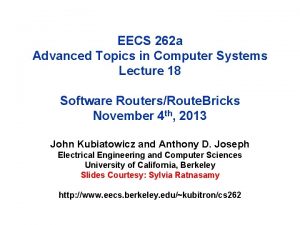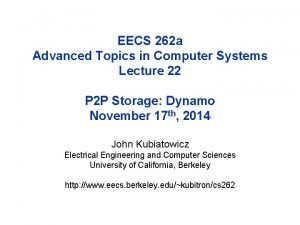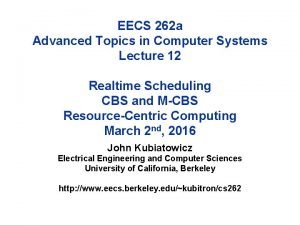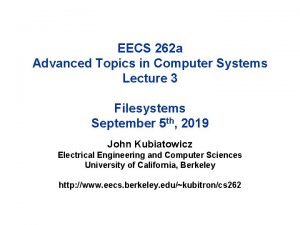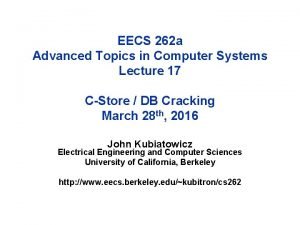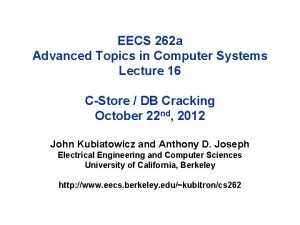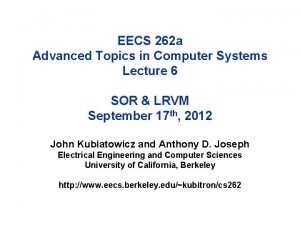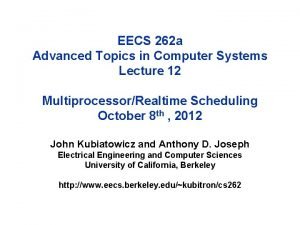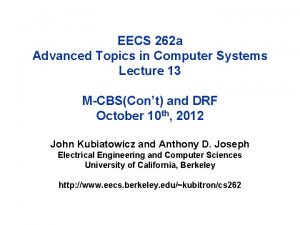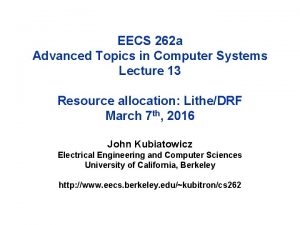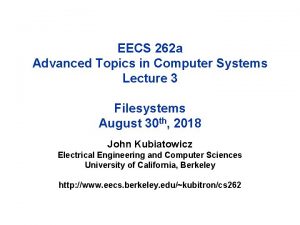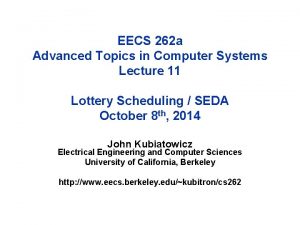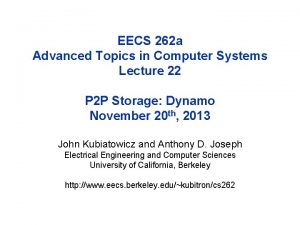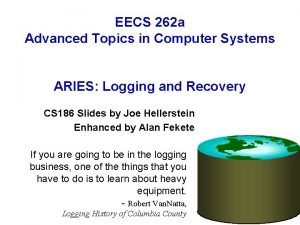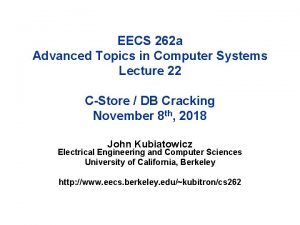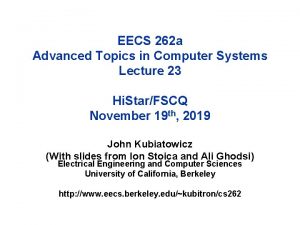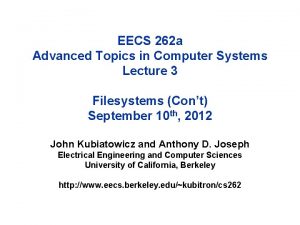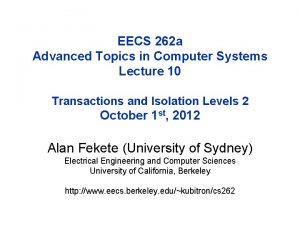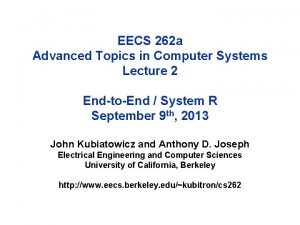EECS 262 a Advanced Topics in Computer Systems











![• Must be available when partitions happen • “Many traditional […]. In such • Must be available when partitions happen • “Many traditional […]. In such](https://slidetodoc.com/presentation_image/fae3c7d7697e8e1944fa19d53878ab91/image-12.jpg)





































- Slides: 49

EECS 262 a Advanced Topics in Computer Systems Lecture 9 CRDTs and Coordination Avoidance September 26 th, 2019 John Kubiatowicz Based on slides by Ali Ghodsi and Ion Stoica http: //www. eecs. berkeley. edu/~kubitron/cs 262

Replicated Data • Replicate data at many nodes – Performance: local reads – Fault-tolerance: no data loss unless all replicas fail or become unreachable – Availability: data still available unless all replicas fail or become unreachable – Scalability: load balance across nodes for reads • Updates – Push to all replicas – Consistency: expensive! 9/26/2019 cs 262 a-F 19 Lecture-09 2

Conflicts • Updating replicas may lead to different results inconsistent data 9/26/2019 s 1 5 s 2 5 s 3 5 3 7 7 3 cs 262 a-F 19 Lecture-09 3

Strong Consistency • All replicas execute updates in same total order – Deterministic updates: same update on same objects same result s 1 5 s 2 5 s 3 5 3 7 3 7 7 coordinate 9/26/2019 cs 262 a-F 19 Lecture-09 4

Strong Consistency • All replicas execute updates in same total order – Deterministic updates: same update on same objects same result • Requires coordination and consensus to decide on total order of operations – N-way agreement, basically serialize updates very expensive! 9/26/2019 cs 262 a-F 19 Lecture-09 5

CAP theorem • Can only have two of the three properties in a distributed system • Consistency. Always return a consistent results (linearizable). As if there was only a single copy of the data. • Availability. Always return an answer to requests (faster than really long lived partitions). • Partition-tolerance. Continue operating correctly even if the network partitions. 9/26/2019 cs 262 a-F 19 Lecture-09 6

CAP theorem v 2 • When the networked is partitioned, you must chose one of these • Consistency. Always return a consistent results (linearizable). As if there was only a single copy of the data. • Availability. Always return an answer to requests (faster than really long lived partitions). • How can we get around CAP? 9/26/2019 cs 262 a-F 19 Lecture-09 7

Eventual Consistency to the rescue • If no new updates are made to an object all replicas will eventually converge to the same value • Update local and propagate – No consensus in the background scale well for both reads and writes – Expose intermediate state – Assume, eventual, reliable delivery • On conflict, applications – Arbitrate & Rollback 9/26/2019 cs 262 a-F 19 Lecture-09 8

Eventual Consistency • If no new updates are made to an object all replicas will eventually converge to the same value • However – High complexity – Unclear semantics if application reads data and then we have a rollback! 9/26/2019 cs 262 a-F 19 Lecture-09 9

9/26/2019 cs 262 a-F 19 Lecture-09 10

• Must be available when partitions happen • “For example, customers should be able to view and add items to their shopping cart even if disks are failing, network routes are flapping, or data centers are being destroyed by tornados. Therefore, the service responsible for managing shopping carts requires that it can always write to and read from its data store, and that its data needs to be available across multiple data centers. ” • Handles 3 million checkouts a day (2009). Availability! 9/26/2019 cs 262 a-F 19 Lecture-09 11
![Must be available when partitions happen Many traditional In such • Must be available when partitions happen • “Many traditional […]. In such](https://slidetodoc.com/presentation_image/fae3c7d7697e8e1944fa19d53878ab91/image-12.jpg)
• Must be available when partitions happen • “Many traditional […]. In such systems, writes may be rejected if the data store cannot reach all (or a majority of) the replicas at a given time. On the other hand, Dynamo targets the design space of an “always writeable” data store (i. e. , a data store that is highly available for writes). […] For instance, the shopping cart service must allow customers to add and remove items from their shopping cart even amidst network and server failures. This requirement forces us to push the complexity of conflict resolution to the reads in order to ensure that writes are never rejected” 9/26/2019 cs 262 a-F 19 Lecture-09 12

• Must be available when partitions happen • “There is a category of applications in Amazon’s platform that can tolerate such inconsistencies and can be constructed to operate under these conditions. For example, the shopping cart application requires that an “Add to Cart” operation can never be forgotten or rejected. If the most recent state of the cart is unavailable, and a user makes changes to an older version of the cart, that change is still meaningful and should be preserved. Note that both “add to cart” and “delete item from cart” operations are translated into put requests to Dynamo. When a customer wants to add an item to (or remove from) a shopping cart and the latest version is not available, the item is added to (or removed from) the older version and the divergent versions are reconciled later. . ” 9/26/2019 cs 262 a-F 19 Lecture-09 13

Today’s Papers • CRDTs: Consistency without concurrency control Marc Shapiro, Nuno Preguica, Carlos Baquero, Marek Zawirski Research Report, RR-6956, INRIA, 2009 • Coordination Avoidance in Database Systems Peter Bailis, Alan Fekete, Michael J. Franklin, Ali Ghodsi, Joseph M. Hellerstein, Ion Stoica, Proceedings of VLDB’ 14 • Thoughts? 9/26/2019 cs 262 a-F 19 Lecture-09 14

Main idea of CRDTs • What does CRDT stand for? – Commutative Replicated Data Type? – Conflict-free Replicated Data Type? – Both…. • In a CRDT data structure: – If concurrent updates to replicas commute and all replicas execute updates in causal order, then replicas converge – Leverages simple mathematical properties that ensure absence of conflict such as monotonicity in a semi-lattice and/or commutativity • How does CRDTs get around consistency problems of eventual consistency? – Create many specialized APIs with custom semantics • • Shopping cart might need a SET instead of PUT/GET A search engine might need a distributed DAG • CS Research Trick: assume more semantics. More limited applicability, but can do things that were impossible before! 9/26/2019 cs 262 a-F 19 Lecture-09 15

Strong Eventual Consistency • Strong Eventual Consistency (SEC): – Eventual Consistency with the guarantee that correct replicas that have received the same updates (maybe in different order) have an equivalent correct state! • Like eventual consistency but with deterministic outcomes of concurrent updates – No need for background consensus – No need to rollback – Available, fault-tolerant, scalable 9/26/2019 cs 262 a-F 19 Lecture-09 16

Treedoc: A CRDT for Wikipedia • A Data structure for storing articles – Many replicas of documents – Document fragments (words/paragraphs) stored in tree » Fragments assembled in depth-first, left-to-right order • Each node in tree has unique ID based on path to node – Elements inserted by adding to tree at proper place (may unbalance tree) – Deletes labeled in tree but not immediately removed – Uniqueness (between replicas) enforced by adding tie-breaker based on replica nameh • Epidemic replication now works – just send all updates (tuple [ID, Text] or [ID, Delete]) to everyone • Periodic, all-replica compression by flattening and rebuilding tree – Requires consensus, but only rarely – Needs to be aborted if ongoing updates at any replica 9/26/2019 cs 262 a-F 19 Lecture-09 17

Treedoc: A CRDT for Wikipedia 9/26/2019 cs 262 a-F 19 Lecture-09 18

Treedoc size over time (GWB page) • George W Bush Wikipedia page gets lots of editing (read – “hacking”) and becomes good test case: 9/26/2019 cs 262 a-F 19 Lecture-09 19

Was This a good paper? ? • What were the authors’ goals? • What about the evaluation / metrics? • Did they convince you that this was a good system /approach? • Were there any red-flags? • What mistakes did they make? • Does the system/approach meet the “Test of Time” challenge? • How would you review this paper today? 9/26/2019 cs 262 a-F 19 Lecture-09 20

CS 262 a Project • Mini-Research Projects: Actually advance state-of-art – Need two or three people/project (may allow four undergrads/project) – Complete Research project in 2/3 of a term » Typically investigate hypothesis by building an artifact and measuring it against a “base case” » Generate conference-length paper and give oral presentation at poster session » Often, can lead to an actual publication. • I will meet with groups 2 or 3 times during term to brainstorm – Many projects supported by other faculty and/or grad students 9/26/2019 cs 262 a-F 19 Lecture-09 21

CS 262 a Project (con’t) • Proposal due in week and a half – Finally going to put up some projects today or tomorrow – Suggested by systems faculty • Most important things: – What are you going to do? – What are your metrics for success? – What resources do you need? 9/26/2019 cs 262 a-F 19 Lecture-09 22

Coordination Avoidance in DB Systems • Serializability is really expensive in distributed databases: • Conclusion: Do as little coordination as possible! 9/26/2019 cs 262 a-F 19 Lecture-09 23

Example of what we want to do: 9/26/2019 cs 262 a-F 19 Lecture-09 24

System Model: I-confluent execution • A set of trasactions T is -confluent with respect to invariant I if for all reachable states with common ancestor state, merged state is still I-valid: 9/26/2019 cs 262 a-F 19 Lecture-09 25

Useful idea? 9/26/2019 cs 262 a-F 19 Lecture-09 26

Result for TPC-C 9/26/2019 cs 262 a-F 19 Lecture-09 27

Was This a good paper? ? • What were the authors’ goals? • What about the evaluation / metrics? • Did they convince you that this was a good system /approach? • Were there any red-flags? • What mistakes did they make? • Does the system/approach meet the “Test of Time” challenge? • How would you review this paper today? 9/26/2019 cs 262 a-F 19 Lecture-09 28

Generalization (Optional Paper) • Conflict-free Replicated Data Types – Marc Shapiro, Nuno Preguica, Carlos Baquero, Marek Zawirski, 2011 • What are general properties of such conflict-free data structures? • Two classes of replication: State-based and Operation-based 9/26/2019 cs 262 a-F 19 Lecture-09 29

Partial Order (poset) • Set of objects S and an order relationship ≤ between them, such that for all a, b, c in S • Reflexive: a ≤ a • Antisymmetric: ( a ≤ b ∧ b ≤ a ) ⇒ ( a = b ) • Transitive: ( a ≤ b ∧ b ≤ c ) ⇒ ( a ≤ c ) 9/26/2019 cs 262 a-F 19 Lecture-09 30

Semi-lattice • Partial order ≤ set S with a least upper bound (LUB), denoted ⊔ – m = x ⊔ y is a LUB of {x, y} under ≤ iff ∀ m′ ( x ≤ m′ ∧ y≤ m′) ⇒ ( x ≤ m ∧ y ≤ m ∧ m ≤ m′ ) • The nice thing about semi-lattices is that it follows that ⊔ is: – commutative: x ⊔ y = y ⊔ x – idempotent: x ⊔ x = x – associative: ( x ⊔ y) ⊔ z = x ⊔ ( y⊔ z) 9/26/2019 cs 262 a-F 19 Lecture-09 31

Example • Partial order ≤ on set of integers • ⊔: max( ) • Then, we have: – commutative: max(x, y) = max(y, x) – idempotent: max(x, x) = x – associative: max(x, y), z) = max(x, max(y, z)) 9/26/2019 cs 262 a-F 19 Lecture-09 32

Example • Partial order ⊆ on sets • ⊔: U (set union) • Then, we have: – commutative: A U B = B U A – idempotent: A U A = A – associative: (A U B) U C = A U (B U C) 9/26/2019 cs 262 a-F 19 Lecture-09 33

Aha! • How can this help us in building replicated distributed systems? • Just use the LUB ⊔ to merge state between replicas • For instance, could build a CRDT using • Supports add(integer) • Supports get returns the maximum integer • How? • Always correct: available and strongly eventually consistent – Can we support remove(integer)? 9/26/2019 cs 262 a-F 19 Lecture-09 34

State-based Replication • Replicated object: a tuple (S, s 0, q, u, m). – Replica at process pi has state si ∈ S – s 0: initial state • Each replica can execute one of following commands – q: query object’s state – u: update object’s state – m: merge state from a remote replica 9/26/2019 cs 262 a-F 19 Lecture-09 35

State-based Replication • Algorithm – Periodically, replica at pi sends its current state to pj – Replica pj merges received state into its local state by executing m • After receiving all updates (irrespective of order), each replica will have same state 9/26/2019 cs 262 a-F 19 Lecture-09 36

Monotonic Semi-lattice Object • A state-based object with partial order ≤, noted (S, ≤, s 0, q, u, m), that has following properties, is called a monotonic semi-lattice: 1. Set S of values forms a semi-lattice ordered by ≤ 2. Merging state s with remote state s′ computes the LUB of the two states, i. e. , s • m (s′ ) = s⊔s′ 3. State is monotonically non-decreasing across updates, i. e. , s ≤ s • u 9/26/2019 cs 262 a-F 19 Lecture-09 37

Convergent Replicated Data Type (Cv. RDT) • Theorem: Assuming eventual delivery and termination, any state-based object that satisfies the monotonic semi-lattice property is • SEC 9/26/2019 cs 262 a-F 19 Lecture-09 38

Why does it work? • Don’t care about order: – Merge is both commutative and associative • Don’t care about delivering more than once – Merge is idempotent 9/26/2019 cs 262 a-F 19 Lecture-09 39

Numerical Example: Union Set • u: add new element to local replica • q: return entire set • merge: union between remote set and local replica {5} U {3} = {3, 5} U {5, 7} = {3, 5, 7} {5} {5} U {3, 5} = {3, 5} {5} {3, 5} U {5, 7} = {3, 5, 7} {5} U {7} = {5, 7} U {3, 5} = {3, 5, 7} 9/26/2019 cs 262 a-F 19 Lecture-09 40

Operation-based Replication • An op-based object is a tuple (S, s 0, q, t, u, P ), where S, s 0 and q have same meaning: state domain, initial state and query method – – 9/26/2019 No merge method; instead an update is split into a pair (t, u ), where t: side-effect-free prepare-update method (at local copy) u: effect-free update method (at all copies) P: delivery precondition (see next) cs 262 a-F 19 Lecture-09 41

Operation-based Replication • Algorithm – Updates are delivered to all replicas – Use causally-ordered broadcast communication protocol, i. e. , deliver every message to every node exactly once, consistent with happenbefore order – Happen-before: updates from same replica are delivered in the order they happened to all recipients (effectively delivery precondition, P) – Note: concurrent updates can be delivered in any order 9/26/2019 cs 262 a-F 19 Lecture-09 42

Commutative Replicated Data Type (Cm. RDT) • Assuming causal delivery of updates and method termination, any op-based object that satisfies the commutativity property for all concurrent updates is SEC 9/26/2019 cs 262 a-F 19 Lecture-09 44

Numerical Example: Union Set • t: add a set to local replica • u: add delta to every remote replica {5} U {3} = {3, 5} U {5, 7} = {3, 5, 7} {5} {5} U {3} = {3, 5} U {5, 7} = {3, 5, 7} {5} {5} U {5, 7} = {5, 7} 9/26/2019 {5, 7} U {3} = {3, 5, 7} cs 262 a-F 19 Lecture-09 45

State-based vs Op-based State Based CRDT (Cv. RDT) Op Based CRDT (Cm. RDT) What is the differences and why might it matter? 9/26/2019 cs 262 a-F 19 Lecture-09 46

State-based vs Operation-based Replication • Both are equivalent! – You can use one to emulate the other • Operation-based – More efficient since you can ship only small updates, but requires causally-ordered broadcast • State-based – Just requires reliable broadcast; causallyordered broadcast much more complex! But requires sending all state 9/26/2019 cs 262 a-F 19 Lecture-09 47

CRDT Examples (cont’d) • Integer vector (virtual clock): – u: increment value at corresponding index by one, inc(i) – m: maximum across all values, e. g. , m([1, 2, 4], [3, 1, 2]) = [3, 2, 4] • Counter: use an integer vector, with query operation – q: returns sum of all vector values (1 -norm), e. g. , q([1, 2, 4]) = 7 • Counter that decrements as well: – Use two integer vectors: » I updated when incrementing » D updated when decrementing – q: returns difference between 1 -norms of I and D 9/26/2019 cs 262 a-F 19 Lecture-09 48

CRDT Examples (cont’d) • Add only set object – u: add new element to set – m: union between two sets – q: return local set • Add and remove set object – Two add only sets » A: when adding an element, add it to A » R: when removing an element, add it to R – q: returns AR (only supports adding an element at most once) 9/26/2019 cs 262 a-F 19 Lecture-09 49

Summary • Serialization, strong consistency – Easy to use by applications, but don’t scale well due to conflicts • Two solutions to dramatically improve performance: – CRDTs: eliminate coordination by restricting types of supported objects for concurrent updates – Coordination avoidance: rely on application hints to avoid coordination for transactions 9/26/2019 cs 262 a-F 19 Lecture-09 52
 Advanced topics in computer science
Advanced topics in computer science Cis262
Cis262 Cis 262 upenn
Cis 262 upenn Cis262
Cis262 Matrix multiplication 2x1 1x2
Matrix multiplication 2x1 1x2 Automata, computability, and complexity
Automata, computability, and complexity Advanced topics in software engineering
Advanced topics in software engineering Angular advanced topics
Angular advanced topics Angular advanced topics
Angular advanced topics Advanced c topics
Advanced c topics Advanced topics in web development
Advanced topics in web development Android advanced topics
Android advanced topics Embedded systems topics for presentation
Embedded systems topics for presentation Computer organization topics
Computer organization topics Computer and society topics
Computer and society topics Advanced fusion systems llc
Advanced fusion systems llc Advanced fueling systems
Advanced fueling systems Cs598
Cs598 Advanced fluid systems york pa
Advanced fluid systems york pa Tom kilcer advanced ag systems
Tom kilcer advanced ag systems Advanced systems integration
Advanced systems integration Advanced embedded systems
Advanced embedded systems Projection slice theorem
Projection slice theorem Advanced cooling systems inc
Advanced cooling systems inc Review of fundamentals of cpu
Review of fundamentals of cpu Craig reinhart
Craig reinhart Advanced computer forensics
Advanced computer forensics Advanced computer forensics
Advanced computer forensics Decision support systems and intelligent systems
Decision support systems and intelligent systems Principles of complex systems for systems engineering
Principles of complex systems for systems engineering Embedded systems vs cyber physical systems
Embedded systems vs cyber physical systems Elegant systems
Elegant systems Computer control of manufacturing systems
Computer control of manufacturing systems Ecor 1010
Ecor 1010 Dedicated computer
Dedicated computer Computer network vs distributed system
Computer network vs distributed system Key frame systems in computer graphics
Key frame systems in computer graphics Function of system unit
Function of system unit In css nc ii, avr stands for
In css nc ii, avr stands for Unit 2 task 1
Unit 2 task 1 The protection of information in computer systems
The protection of information in computer systems What are the advantages of computerized accounting
What are the advantages of computerized accounting Computer assisted guidance systems
Computer assisted guidance systems Computer systems
Computer systems Cs 1104 final exam
Cs 1104 final exam Cit computer systems
Cit computer systems Computer systems components
Computer systems components Computer system performance analysis
Computer system performance analysis Cit 593 introduction to computer systems
Cit 593 introduction to computer systems Integration using tables
Integration using tables

